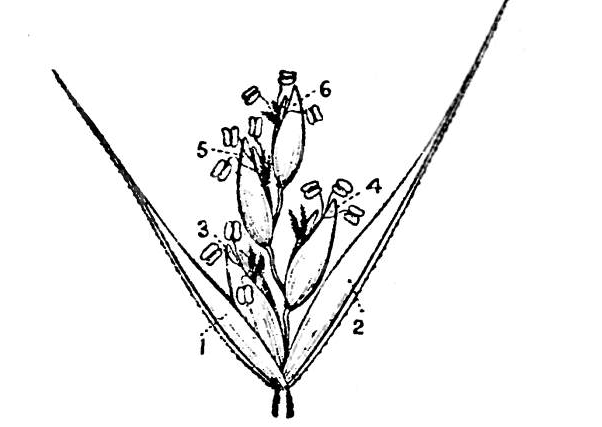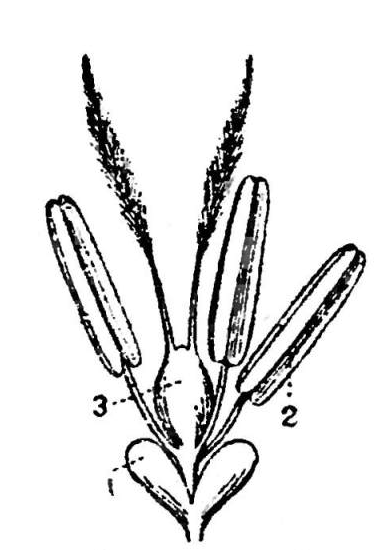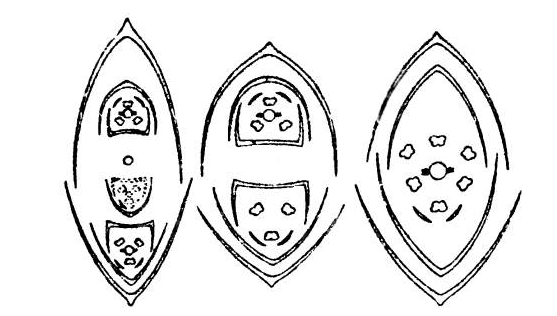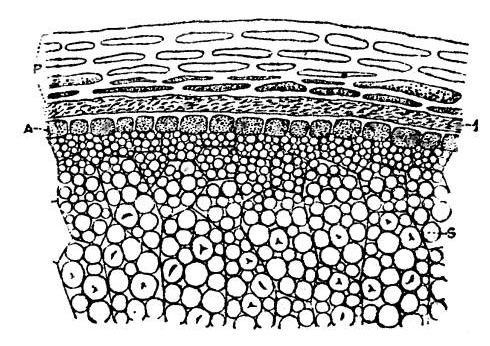A Handbook Of Some Common South Indian Grasses: 4-The Inflorescence And Flower
This is an extract from |
Contents |
The Inflorescence And Flower
The flowers of grasses are reduced to their essential organs, the stamens and the pistil. The flowers are aggregated together on distinct shoots constituting the inflorescence of grasses. Sooner or later all the branches of a grass-plant terminate in inflorescences which usually stand far above the foliage leaves. As in other flowering plants, in grasses also different forms of inflorescence are met with. But in grasses the unit of the inflorescence is the spikelet and not the flower.
The forms of inflorescence usually met with are the spike, raceme and panicle. When the spikelets are sessile or borne directly along an elongated axis as in Enteropogon melicoides the inflorescence is a spike. If the spikelets borne by the axis are all stalked, however short the pedicels may be, it is a raceme.
It must, however, be remembered that true spikes are very rare. An inflorescence may appear to be a spike, but on a close examination it will be seen to consist of spikelets more or less pedicelled. Such an inflorescence, strictly speaking, is a spiciform raceme. The branches of the inflorescence in Paspalum scrobiculatum or Panicum javanicum are racemes and the whole inflorescence is a compound raceme.
The inflorescence is a panicle when the spikelets are borne on secondary, tertiary or further subdivided branches. Panicles differ very much in appearance according to the relative length and stoutness of the branches. In Eragrostis tremula the panicle is very diffuse, in Eragrostis Willdenoviana less so. The panicle in Sporobolus coromandelianus is pyramidal and the branches are all verticillate, the lower being longer than the upper. The branches of a panicle are usually loose, spreading or drooping in most grasses.
But in some species of grasses such as Pennisetum Alopecuros and Setaria glauca, the paniculate inflorescences become so contracted that the pedicels and the short branches are hidden and the inflorescence appears to be a spike. Such inflorescences as these are called spiciform panicles. The inflorescences in several species of Andropogon consist of racemes so much modified as to appear exactly like a spike. What looks like a spike in these cases consists of a jointed axis and each joint bears a pair of spikelets, one sessile and the other pedicelled.
The name rachis is given to the axis of the spike, raceme and panicle, whether the axis is the main one or of the branch. The rachis of the inflorescence is usually cylindrical. In some grasses it is zigzag as in Pennisetum cenchroides. It is very much flattened in Paspalum scrobiculatum, but somewhat trigonous in Digitaria sanguinalis.
In very many grasses the rachis is continuous, but in a few cases it consists of internodes or joints which disarticulate at maturity. Many species of Andropogon have such jointed rachises. Sometimes the joints become greatly thickened and the surface hollowed out, the spikelets fitting in the cavities as in Rottboellia and Manisuris.
In panicles, especially when they are diffuse, the primary branches may be disposed irregularly or in verticils on the main axis. For example in the panicle of Eragrostis Willdenoviana, the branches are irregularly disposed, whereas in Sporobolus coromandelianus the branches are verticillate. In both these grasses fleshy cushions are developed in the axils of the branches. These swellings help to spread out the branches especially at the time of anthesis. The branches at the top spread out earlier than those below.
Sometimes at the base of the rachises, main or secondary, glandular streaks are seen as in the rachises of Sporobolus coromandelianus. These glands secrete a viscid juice at the time of anthesis.
The spikelet may be considered as a specialised branch consisting of a short axis, the rachilla bearing a series of modified bracts, the glumes, the lower pair being empty but the others bearing flowers in their axils. The glumes are two-ranked and imbricating. As a type for the spikelet that of an Eragrostis or Dinebra may be chosen. (See fig. 17.) In this spikelet the rachilla bears a number of glumes alternating and imbricating. The first two glumes at the base of the spikelet do not bear any flowers and so these two glumes are usually called empty glumes.
This is the case in almost all the species of grasses. The third and the subsequent glumes are regularly arranged on the slender rachilla alternately in two rows. In the axils of each of these glumes there is a flower, except perhaps in the topmost glume. The flower is usually enclosed by the glume and another structure found opposite the glume and differing very much from the glume. This is the palea.
It is attached to the axis of the flower and its back is towards the rachilla. Generally there are two nerves in a palea and its margins are enclosed within those of the glume. The palea is homologous with the prophyllum which it very much resembles. The prophyllum is usually found in the branches of grasses, but it is not confined to grasses alone. It occurs in the branches of some species of Commelina.
The spikelets vary very much in their structure. The spikelets in grasses of several genera consist of only four glumes. As usual the first two glumes are empty and the remaining two are flower-bearing glumes. Both these glumes may have perfect flowers as in Isachne or the terminal one may contain a perfect flower, the [Pg 15]lower having either a staminate flower or only a palea.
Very often the spikelets are unisexual and the male and female spikelets may be on the same plant as in Coix Lachryma-Jobi and Polytoca barbata, or they may be on different plants as in Spinifex squarrosus.
The glumes of a spikelet are really modified bracts and some differentiate the flowering glumes from the empty ones, by giving them different names. The first two empty glumes are called glumes by all agrostologists. Some in Europe call the flowering glume lower palea to distinguish it from the real palea which they call the upper palea. Some American Authors have recently adopted for the flowering glume the term lemma introduced by Piper.
Considerable variation is met with in the case of the empty glumes. Generally they are unequal, the first being smaller. Very often the first glume becomes very small and it may be altogether absent. In some species of Panicum the first glume is very small, in Digitaria it is very minute and in Paspalum and Eriochloa it is entirely suppressed. The flowering glumes are generally uniform when there are many.
In the spikelet having only four glumes the fourth glume differs from the others mainly in texture. Instead of being thin and herbaceous it becomes rigid and hard, smooth or rugose externally as in Panicum. Flowering glumes instead of being like empty glumes, become very thin, shorter and hyaline in Andropogon. Sometimes the flowering glumes are awned. All of them may be awned as in Chloris or only the fourth glume as in Andropogon.
The palea is fairly uniform in its structure in many grasses, but it is also subject to variation. It becomes shorter in some and is absent in others. Instead of having two nerves, it may have one and rarely more than two. The palea can easily be distinguished from the glume, because its insertion in the spikelet is different from that of the glume.
Lodicules
The lodicules are small organs and they are the vestiges of the perianth. In most grasses there are only two, but in Ochlandra and other bamboos we meet with three lodicules. There are also some species with many lodicules. In shape they are mostly of some form referable to the cuneate form. They are of somewhat elongated form in Aristida and Chloris. The function of the lodicules seems to be to separate the glume and its palea so as to enable the stamens to come out and hang freely at the time of anthesis. So it is only at the time of the opening of the flowers that the lodicules are at their best. Then they are fairly large, fleshy and thick and conspicuous. In the bud stage they are usually small and after the opening of the flower they shrivel up and are inconspicuous. There are also species of grasses in which the lodicules are not found.
Stamens
The stamens are three in number in the majority of grasses and six are met with in Leersia, Hygrorhiza and Bamboos. Each stamen consists of a very delicate long filament and an anther basifixed to the filament. But as the anthers are long and the connective is reduced to its minimum, they appear as if versatile when the stamens are out. When there are three stamens one stands in front of the flowering glumes and the other two in front of the palea, one opposite each edge of the palea. The relative positions of the parts of the floret are shown in the floral diagrams.
Pistil
The pistil consists of an ovary and two styles ending in plumose stigmas. The ovary is 1-celled and 1-ovuled. It is one carpelled according to the views of Hackel and his followers and there are also some who consider it as 3-carpelled because of the occurrence of three styles in the pistil of some bamboos.
Rachilla
The rachilla is usually well developed and elongated in many-flowered spikelets, while in 1-flowered spikelets it remains very small so that the flower appears to be terminal. It often extends beyond the insertion of the terminal flower and its glume, and then lies hidden appressed to the palea. This may be seen in the spikelets of the species of Cynodon. This prolonged rachilla sometimes bears a minute glume, which is of course rudimentary. Usually the glumes are rather close together on the rachilla so that the internodes are very short; but in some grasses, as in Dinebra arabica, the glumes are rather distant and so the internodes are somewhat longer and conspicuous.
In some species of Panicum the rachilla is jointed to the pedicel below the empty glumes, whereas it is articulated just above these glumes in Chloris barbata. Sometimes the rachilla is articulated between the flowers. This is the case in the spikelet of Dinebra arabica.
Pollination in most grasses is brought about by wind, though in a few cases self-pollination occurs. The terminal position of the inflorescence, its protrusion far above the level of the foliage leaves, the swinging and dangling anthers, the abundance of non-sticking pollen and the plumose stigmas are all intended to facilitate pollination by wind. Furthermore the stamens and the stigmas do not mature at the same time.
In some grasses the stamens mature earlier, (protandry) while in others the stigmas protrude long before the stamens (protogyny). As the result of the pollination the ovary developes into a dry 1-seeded indehiscent fruit. The seed fills the cavity fully and the pericarp fuses with the seed-coat [Pg 17]and so they are inseparable. Such a fruit is termed a caryopsis or grain. Though in the vast majority of grasses the pericarp is inseparable, in a few cases it is free from the seed-coat as in Sporobolus indicus and Eleusine indica.
The caryopsis consists of an embryo on one side at the base and the endosperm occupies the remaining portion. The embryo can be made out on the side of the grain facing the glume, as it is outlined as an oval area. On the other face of the grain which is towards the palea, the hilum is seen at the base. The grain varies in shape considerably. It may be rounded, oval, ellipsoidal, narrow and cylindrical, oblong terete or furrowed. There is considerable variation as regards the colour also.
Embryo
The embryo consists of an axis and a scutellum. The axis, which is differentiated into the plumule directed upward and the radicle downward, is small and straight and it is covered more or less by the edges of the scutellum. The scutellum is attached to the axis at about its middle and its outer surface is in contact with the endosperm. This is an important organ as its function is to absorb nourishment from the endosperm during germination. The scutellum is considered to represent the first leaf or cotyledon.
The endosperm consists mostly of starch. Just outside the endosperm and within the epidermis lies a layer of cells containing much proteid substance. This layer is called the aleurone layer.As an illustration of the caryopsis, the grain of Andropogon Sorghum may be studied. All the structural details are shown in fig. 20 which is a longitudinal section of the grain.
The primary axis of the embryo is enclosed by a closed sheath both above and below. The sheath which envelopes the radicle is called coleorhiza and that of the plumule, pileole or germ-sheath.




